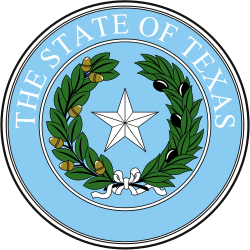1976 United States House of Representatives elections in Texas
The 1976 United States House of Representatives elections in Texas occurred on November 2, 1976, to elect the members of the state of Texas's delegation to the United States House of Representatives. Texas had twenty-four seats in the House apportioned according to the 1970 United States census.[1] Texas underwent mid-decade redistricting as a result of the U.S. Supreme Court case White v. Weiser. The court's modified districts were used in 1974. In 1975, the Texas Legislature modified the boundaries District 2 and District 6 to move the town of Streetman, which is on the border of Navarro County and Freestone County, fully within the boundaries of District 6.[2][3] These elections occurred simultaneously with the United States Senate elections of 1976, the United States House elections in other states, the presidential election, and various state and local elections. Democrats maintained their majority of U.S. House seats from Texas, gaining two seats from the Republicans, increasing their majority to twenty-two out of twenty-four seats.[4] Overview
Congressional districtsDistrict 1Incumbent Democrat Wright Patman, the Dean of the House, died on March 7, 1976.[6] This prompted a special election to be held, which was won by fellow Democrat Sam B. Hall.[7]
District 2Incumbent Democrat Charlie Wilson ran for re-election.
District 3Incumbent Republican James M. Collins ran for re-election.
District 4Incumbent Democrat Ray Roberts ran for re-election.
District 5Incumbent Republican Alan Steelman retired to run for U.S. Senator.[8]
District 6Incumbent Democrat Olin E. Teague ran for re-election.
District 7Incumbent Republican Bill Archer ran for re-election unopposed.
District 8Incumbent Democrat Bob Eckhardt ran for re-election.
District 9Incumbent Democrat Jack Brooks ran for re-election unopposed.
District 10Incumbent Democrat J. J. Pickle ran for re-election.
District 11Incumbent Democrat William R. Poage ran for re-election.
District 12Incumbent Democrat Jim Wright ran for re-election.
District 13Incumbent Democrat Jack Hightower ran for re-election.
District 14Incumbent Democrat John Andrew Young ran for re-election.
District 15Incumbent Democrat Kika de la Garza ran for re-election.
District 16Incumbent Democrat Richard Crawford White ran for re-election.
District 17Incumbent Democrat Omar Burleson ran for re-election unopposed.
District 18Incumbent Democrat Barbara Jordan ran for re-election.
District 19Incumbent Democrat George H. Mahon ran for re-election.
District 20Incumbent Democrat Henry B. González ran for re-election unopposed.
District 21Incumbent Democrat Bob Krueger ran for re-election.
District 22Incumbent Democrat Robert R. Casey resigned to become commissioner to the United States Maritime Commission.[9] This prompted a special election to be held. Republican Ron Paul won the election in a runoff against former State Senator Robert Gammage, running primarily on Libertarian economic issues, flipping the district.[10][11] He ran for re-election.
District 23Incumbent Democrat Abraham Kazen ran for re-election unopposed.
District 24Incumbent Democrat Dale Milford ran for re-election.
References
|
||||||||||||||||||||||||||||||||||||||||||||||||||||||||||||||||||||||||||||||||||||||||||||||||||||||||||||||||||||||||||||||||||||||||||||||||||||||||||||||||||||||||||||||||||||||||||||||||||||||||||||||||||||||||||||||||||||||||||||||||||||||||||||||||||||||||||||||||||||||||||||||||||||||||||||||||||||||||||||||||||||||||||||||||||||||||||||||||||||||||||||||||||||||||||||||||||||||||||||||||||||||||||||||||||||||||||||||||||||||||||||||||||||||||||||||||||||||||||||||||||||||||||||||||||||||||||||||||||||||||||||||||||||||||||||||||||||||||||||||||||||||||||||||||||||||||||||||||||||||||||||||||||||||||||||||||||||||||||||||||||||||||||||||||||||||||||||||||||||||||||||||||||||||||||||||||||||||||||||||||||||||||||||||
Portal di Ensiklopedia Dunia















